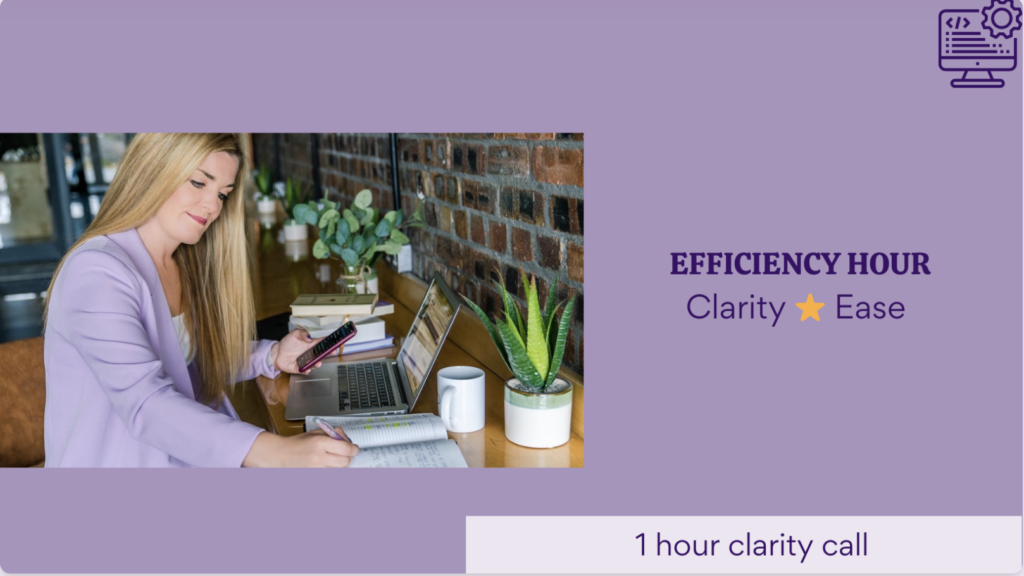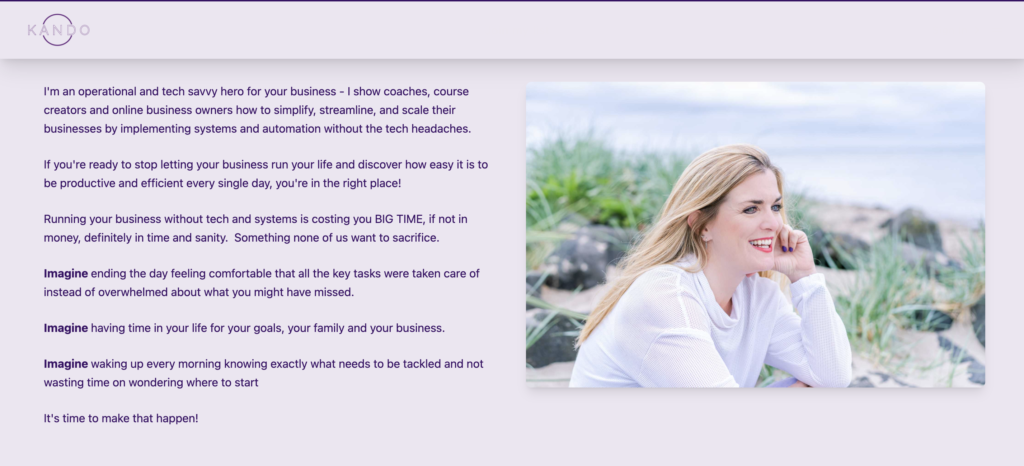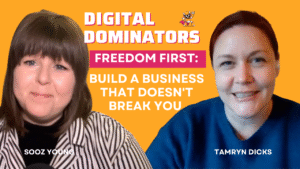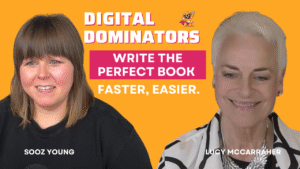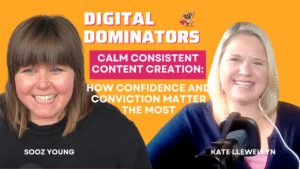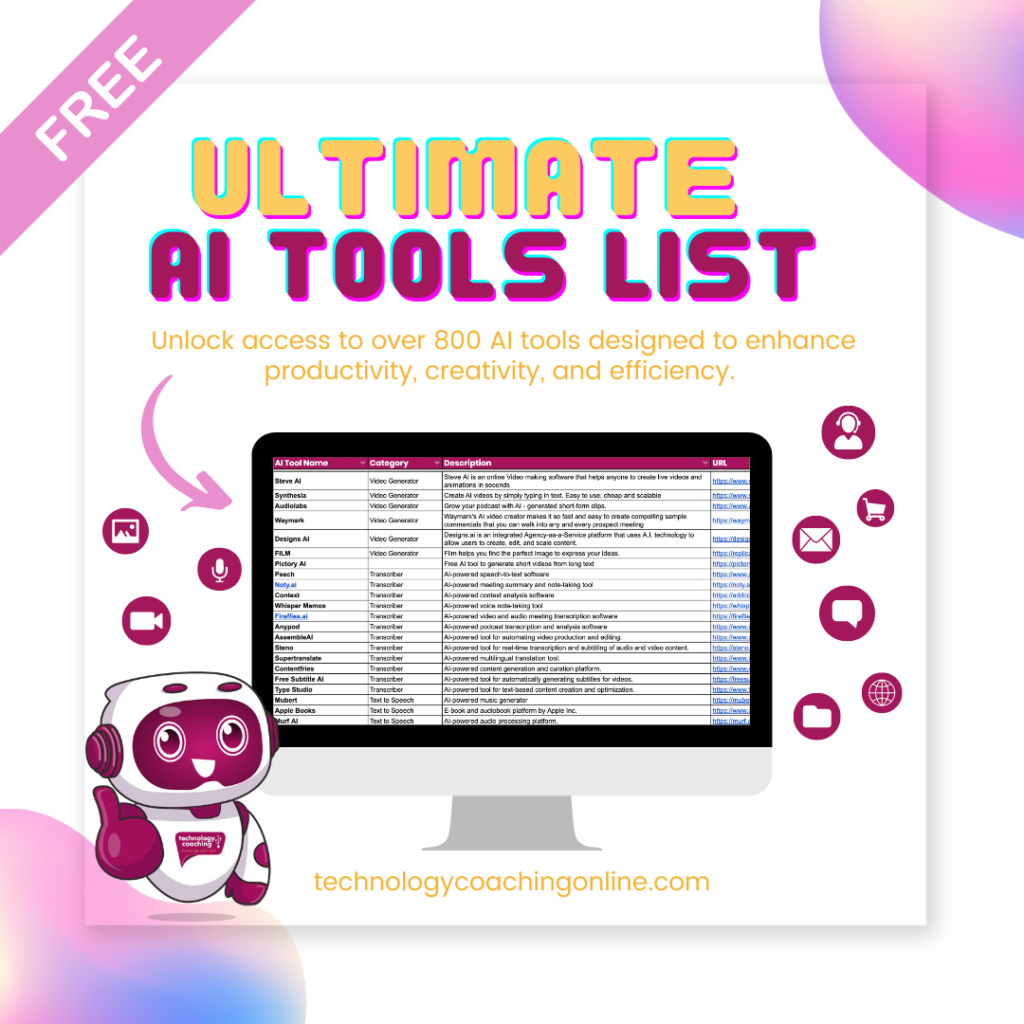Sooz Young 11:03
Hi everyone! Welcome to the Digital Dominator session today brought to you by Technology Coaching.
I’m Sooz, and I’m gonna be your host today.
Today’s session is titled how to boost your business with efficient systems. Today I’m thrilled to have Kay Dewar with us you can see her here say hi Kay.
Kay is an expert in streamlining and automating business systems to help coaches, course creators and online business owners achieve maximum efficiency without the usual tech headaches.
Through her company Kando Support she has transformed countless businesses by simplifying processes and creating seamless operations. Sounds fantastic.
Kay’s unique approach ensures that entrepreneurs can focus on growth and productivity while enjoying more freedom and less stress. So, let’s dive in and learn how to boost your business with efficient systems. So, welcome Kay. Hi, how are you today?
Kay Dewar 11:03 AM
I’m really good, thank you. How are you?
Sooz Young 11:03 AM
I’m good, thank you as well. So, thank you for joining me this morning. I know I shouldn’t say this morning, but we are on this morning. Today’s session is all about how to boost your business with efficient systems. But before we get into that, what would be just really great to know is a bit more about your background.
Kay Dewar 11:04 AM
Yeah, sure. As Sooz mentioned, I am Kay Dewar, and I have been helping businesses to become more productive and efficient for over 20 years, scarily.
My background is that I started as a really curious child and just wondered how things worked, how things joined together, and how you could make things more simple.
That led me into a degree in Maths, which brought together the logic and understanding of how things work and how things actually become what they are.
That then fed into a Master’s in Operations Management.
Ever since graduating, I’ve gone into large corporates to improve operations and really focus on what’s actually important, rather than all the noise of what they can get led to believe is important when it’s not really.
Sooz Young 11:05 AM
I think that last sentence was so, so, so important.
All the things that lead us to think that are keeping us busy, but actually the things that are most important.
But thank you so much for sharing your background there.
I always find it so fascinating to hear everybody’s journey into what it is that they’re doing now because I don’t think that it’s always the same path.
There’s always the path that you think you’re going to go on, but it always navigates into other avenues and opens up other opportunities as you go on in your career-based journey.
I can see why your career journey has got you to where you are today.
So let’s talk a little bit more about those clients that you’re dealing with nowadays.
Tell me a little bit more about who your client is and really what are their needs.
Kay Dewar 11:06 AM
So, clients do vary.
They can be online coaches and course creators.
I’ve got a lot of trade businesses that obviously have multiple members in their team, a lot of people off on various sites, and a lot of moving parts, so it really applies across the board in terms of the business and their needs.
But it’s really all aligned around that same principle of bringing them clarity, reducing the overwhelm, and making sure they are focusing their time effectively because it can become that that’s not the case and they are going down paths that they don’t need to be going down.
So it’s really about bringing them back into that central place that really is the best place for them and their focus.
Sooz Young 11:07 AM
Interesting. So do you find that people get distracted? What is it that they get distracted on then, really, that you can help them, guide them back into what they really should be focusing on?
Kay Dewar 11:07 AM
It can be a variety of things. The overwhelm can build up because all of the really basic day-to-day things are stored in their head, and then they start second-guessing themselves.
They start questioning, is that the right thing? Are they focused on the right thing? It just becomes a mess in their mind when it doesn’t essentially need to be.
Or it can be a case of we’re in a very noisy and busy world now. We’ve got adverts popping at us from everywhere, we’ve got people telling us about new tools, new systems, and they get bogged down thinking that they need something that actually they don’t, and they end up in a bit of a mess because they’ve got four different tools to try and achieve the one outcome essentially.
Sooz Young 11:08 AM
Yeah, I see that myself, Kay.
It’s like, when people come to get some support around their technology that they’ve got set up in their business, it tends to be that somebody’s told them something that they think might be right for them at this minute in time.
But actually, upon the setup process and the actual starting to use the product itself, it’s not usually the right thing for them because somebody’s not had that holistic approach to the tools and where they’re currently at in their business to where they want to be in their business as well.
How do you really start that conversation then with people? What does that look like when people come to you?
Kay Dewar 11:09 AM
So, they want an easier life. They want to take that overwhelm away.
They want their minds to be calmer. They want to just enjoy their business a lot more.
Essentially, that’s where it tends to start. And we then look at, just as you’ve mentioned, that holistic view. We really drill down into what is your business?
What is it you’re trying to achieve? And what steps do you need to do in order to achieve that? So, when you use the word systems, people tend to automatically go to the tech and think systems are the tech.
But a system is essentially the steps that you need to complete to deliver an outcome.
And yes, tech will play a part in that. But it’s that first level of understanding and knowledge that you need to start with.
Kay Dewar 11:10 AM
I spoke to a client just last week, and they booked time with me because they thought they needed automation, they needed tech tools in place.
But actually, before that, they needed a really clear understanding of their customer journey and what the steps involved in that were before they could go and tell the tech what it was that they actually wanted to automate.
So it’s about really bringing them back into that understanding and knowledge of what are you actually trying to do.
Sooz Young 11:10 AM
Yeah, that’s so important, Kay. I think we’re always looking for the new shiny object syndrome.
I got that prompt this morning to say like don’t be distracted by the shiny object, but it’s true.
It’s because there’s constant evolution of digital and tech.
Like, I’m in that industry, I’m constantly getting that shiny object syndrome for the new thing that’s coming out.
However, the implementation of a new tool to get set up in your business, to then find out that it’s not going to work in your business, causes not only a time challenge but also a cost, a learning, and the development for not only yourself but for any team members that work.
And then, what is that experience for that customer in the long run as well?
And I think you’ve raised something really clear there.
When you were talking about your approach, it seems very detailed and thorough.
Kay Dewar 11:11 AM
So, it’s me essentially quizzing them. I’ll ask them hundreds of questions to really understand that business in terms of how are they marketing, how are they bringing people in, what does it look like once they’re in, how do they receive payment, how do they maintain that relationship, how do they retain customers at the other end.
It’s really that full end-to-end piece of the business and anything else that’s involved with that.
When do they then need to pay for their tech tools to make sure that the business keeps running, or do they have vehicles that they need to think about? When do they need to be taken care of?
It’s really that full, holistic picture to make sure every piece of that business is accounted for in the most simple and effective way it can be.
Sooz Young 11:12 AM
Yeah, it’s so important because trying to run a business as a small business owner, you’re basically wearing all of the hats, you’re wearing all of the uniforms for every single role within your business.
I know that from my point of view, we always talk about automating as much of that process as possible, but you do really need to know what your customer journey is and where they’re coming from, where that track is coming from to then how do you set up that process.
And it also depends on the type of business as well. If you’re a brick-and-mortar or if you’re a purely online business, how are people coming to you to then get the support that they need from you as well.
So if I think right back to the start and if I’m going okay, I need to think about improving my systems and efficiency, what’s a good starting point?
Kay Dewar 11:13 AM
If you can think of a map in front of you, a process map, really detail all the high-level points that are involved in your business.
So you are marketing to your customer, you are speaking to customers, you are bringing them into your product or service, you are then delivering that product or service.
Visualise that map in front of you so that you’ve got the clarity. The worst thing we can do is keep it in our head.
We need that visual ability to see, because then we can pinpoint where we can make changes or make improvements.
Then in terms of the next level, it would be really drilling into each of those stages, going into the nitty-gritty of that, in terms of creating what I call a second brain or a digital HQ.
That would go into a tool. My preference is ClickUp. There are a lot of different options out there, and it’s about getting the one that is right for you because the best tool is one that you are actually going to use.
So ClickUp is a task management tool, but it can be built in a way that’s a large digital database, so you’re putting everything related to your business in there, everything that’s in your head, into this database.
Sooz Young 11:14 AM
Okay.
Kay Dewar 11:15 AM
So if you can imagine the flow of all the different elements, you then put in the detailed steps below that.
For example, if you’re talking about marketing, you would have a really detailed description for every single element of that.
If it’s updating blogs on the website, if it’s your content calendar for social media, if it’s your weekly emails that you send out, it’s really drilling into the finest level of detail that you can around that.
So that anyone essentially could come in off the street and pick that up and do that for you. You want your business to be foolproof so that essentially it could run without you as the aim.
Sooz Young 11:15 AM
That is exactly what the goal is for most business owners.
You get to that point where you can say, actually, it’s all running without me. I can go and work on the business and not in the business.
With the high turnover of staff that a lot of companies are dealing with at the moment, it enables that you’re not losing any process.
There are processes that are maybe being set up by an individual in the business, and that’s one of the biggest challenges that corporates have.
And you’ll know this more than me, Kay, but the turnover of staff, the knowledge of the systems that they’ve maybe created as their role leaves with them, and there’s no place for it to stay.
It’s maybe been handed down to the next person, but it’s maybe not detailed enough for them to describe how it works, how it was set up, and all of that as well.
So I suppose that ClickUp sounds almost like, from a corporate language, like that intranet almost, or like that SOP, those standard operating procedures. Is that kind of a relation to what you were talking about there?
Kay Dewar 11:16 AM
Yeah, there are a lot of similarities to SharePoint, for example, but it’s taking it to another level by allowing you to build in the automations, the reminders, the chat functionality.
It’s about bringing everything together into that one place to make your SOPs and your processes and your day-to-day running of the business all linked together and all have that fundamental ability for people to be able to track their way through regardless of where they are in the business.
They know exactly where something is, how to access it, what it’s relating to, and how it ties into all the different tasks or activities that they’re working on.
Sooz Young 11:17 AM
That’s brilliant, Kay.
So I assume that when you start that journey with you, you guide people through that process to be able to set that up on a system like ClickUp as well.
But I assume it’s not that different than it is with maybe other tools that are out there. But again, it’s finding the right tool that’s going to work for you and your business, isn’t it really?
Kay Dewar 11:18 AM
Absolutely. The premise of them all is the same, it’s about bringing everything together in that one central place and having the ability to know that everything essentially talks to each other.
So regardless of what tool you’re using, you’re still going for that same outcome.
Sooz Young 11:18 AM
Okay, great. So what are some common signs that a business might need to improve its systems?
What can you recognise from all the people that you’ve helped over these last 20 years, Kay?
What are the things that you recognise as the most frequent things?
Kay Dewar 11:18 AM
So the language is similar. They are feeling overwhelmed.
They are feeling that they’re not getting enough time to work on the business rather than in the business.
They are getting pretty stressed out in a lot of cases because they just feel that burden, that mental load of carrying everything in their head.
And as humans, we get used to the familiar, so you get almost so used to being overwhelmed and stressed and having that mental burden that it becomes difficult to break that cycle.
So it is a process in itself to take yourself on that journey and get to the other side where the benefits are.
Sooz Young 11:19 AM
Okay. There are those feelings that people get around the feeling of overwhelm that you talked about.
And again, as business owners, we all feel that. Is there anything physically that people might see in the setup of their business that could maybe indicate they need to improve?
Is there anything that you can see from that side of it?
Kay Dewar 11:20 AM
Yes, if you find yourself spending too much time in a week looking for that all-important file that you need to send, or looking for that link that you were meant to send to somebody, or too many back-and-forths trying to arrange something, it’s all those small things that add up.
It’s not the massively important things that take up your time. It’s the small, everyday tasks that, when added together, become a huge time drain.
Sooz Young 11:20 AM
There’s so many online spaces where we all store our stuff as well.
So I know that I have stuff that I store on my own device, that I store on cloud storage, but I also then use multiple different cloud storages as well.
I’ve got client things based in other kinds of storage somewhere. I’ve got to make sure from a cybersecurity setup that I’m not accessing the administrator’s stuff on that same device.
There’s a lot to think about as a business into where do you actually store your content? Where do you store your information?
Then how to get access to it when you need it, when that important message comes through.
Kay Dewar 11:21 AM
Yeah, I would definitely say get this Digital HQ set up. That is the sole purpose of that.
It’s about pulling… So you imagine starting your day every day. That’s the one place that you open.
So yes, you’ve maybe still got all these other cloud storage areas that you need to use, but that one central place will link you directly to that thing that you need.
It’ll have all of your things categorized in a way that’s super easy for you to find. You’re not then going into the cloud storage and ending up in five different folders that you actually don’t need to be in.
It’s just taking you… It’s building that HQ as quickly as you can. And it just stops you having that brain fog moment of trying to remember what folder it was.
Sooz Young 11:22 AM
I’m laughing because I know what that feels like to me.
And does this HQ, as you call it, can you customise it to make it work specifically for your business, or does it tend to be a specific structure that you would recommend that people follow to be able to get it set up?
Kay Dewar 11:23 AM
There is. I’ve been doing it for quite some time now, so I believe my structure is a good way to work it and have that efficiency.
But absolutely, there are tweaks that other people then bring in that work better for them. I tend to implement it for people, take them through why I’ve set it up in that way, and support them.
Sooz Young 11:23 AM
So is that usually your journey that you work with a customer, Kay?
So talk me through what does that customer journey look like from your customer’s point of view to get that HQ set up for them?
Kay Dewar: 11:23 AM
Yeah, so I would take them through that setup.
I would do the initial setup, put as much of their business information in there as I have access to at that point.
I would then train them and or their team to make sure that everyone understood the concept of it, the elements of their business, and really have that embedding-in period to make sure that they’re fully aware of how to get the best use out of it.
And then I find that their way of thinking changes as they get this concept, and all of a sudden they’ve found other efficiencies that they hadn’t even thought about, they hadn’t discussed with me, because they’re now looking at things differently.
Sooz Young 11:24 AM
I love that. I follow the understanding of thinking differently.
So I love how by implementing a tool and making sure it’s set up properly, which is what you’re doing with the business, you’re making sure that it’s set up specifically right for that business.
You’re guiding them and supporting them through that process, but it’s making sure that everyone’s on board with that process too.
How do you deal with those individuals that are resistant to change but know that this change is going to make a huge difference?
You know, like those people that don’t like it? Perhaps we all do as we get older. What would you recommend to people that are resistant to that change?
Kay Dewar 11:25 AM
I do have a bit of a unique way of working on that. I also bring in some psychology-based tools to help with that because it’s human nature; it’s just what we do.
We do look for the familiar, and we do have blocks that prevent us from actually going down a path that’s easier for us.
Sooz Young 11:26 AM
I bet that it’s more the team members that would have that resistance rather than the actual business owners or individuals that have come to you directly because they’ve probably come to you going, “Okay, I need help,” right? You’re probably going to get less resistance.
Kay Dewar: 11:26 AM
Absolutely. It can be the smallest of things. “We’re not too keen on working with this because it looks different to my spreadsheet,” or “I just don’t like the colors,” or it’s the smallest things because that’s just what us humans do.
We just get so used to doing something in a certain way. So yeah, it can be an interesting journey, but it’s really worthwhile once…
Sooz Young: 11:31 AM
I’ve moved away from Loom now, and I use another tool called Komodo.
It does the exact same thing, but there are, as you said, lots of other tools out there. The great thing I love about this tool is that if somebody asks me a question, I will literally record a quick video for them, push them out a link, and it gives them that guide, and it does an AI summary for them as well.
It allows me to have a database of video recordings that I can then push out to people if they need them.
So if I’m thinking like, “Okay, I want to set up the systems for, let’s say, setting up a Digital Dominator session,” I can just use that video recording tool on the browser, record it, and it will generate those instructions with the video.
Kay Dewar 11:32 AM
Yeah, so within ClickUp, you can create templates. So you would create a template for your SOPs.
As soon as you are generating a new one, it would automatically apply the template, and you would then just become clear as to what you needed to pull into which sections, etc.
Sooz Young 11:32 AM
That sounds like it would take just a little bit longer to do when you’re doing that setup process, just maybe a little bit longer than you would normally do if you’ve got this kind of video recording.
But actually, to then hand over that piece of work to somebody else to do, you’re at that great stage where you can start to employ, and then you go, “Actually, I can get an administrator on to help me with that.”
Kay Dewar 11:33 AM
Absolutely. So, when you are outsourcing or bringing people in to support you, one of the biggest reasons that these relationships fail is because of a lack of clarity.
The person didn’t have the clarity as to what your expectations were for that piece of work or that role.
Building in these processes and these SOPs, you’re taking away that major lack of clarity, and that person has no lack of understanding as to what your expectations are.
But it then also does become, so one section is your SOPs, the next section of your digital HQ is your day-to-day operation.
Kay Dewar 11:35 AM
And you can have that as a communication tool as well, and rather than it being lost in a trail of WhatsApp messages or email messages, it’s specifically on the piece of work that it’s in relation to.
So it becomes much easier to keep track of what a person’s done as well.
It just lets that communication be a lot clearer. It cuts out a lot of back-and-forth communication because the clarity is there.
Someone can update and say, “I’ve now done stages 1, 2, and 3 of this piece of work. It’s over to you for the next stage,” as an example.
Sooz Young: 11:35 AM
Oh, that sounds amazing.
So I can envision that as being like, let’s say there’s two members working on a task.
They’re seeing their steps step-by-step, this person’s got to this point, this person can then follow on for the tasks, and then it’s a rinse and repeat almost for the next time that process has to then take place.
That’s so much easier. Everyone’s on the same page.
Kay Dewar: 11:36 AM
Yeah, absolutely. And obviously, once you’ve got the basics in the tool, you can then start to look at the smarter elements of it.
So ClickUp, as an example, you’ve got all your knowledge in there, all your information, your SOPs, your day-to-day running, and then you start adding in the automations.
Then you start telling ClickUp to assign it to a specific person when it gets to a specific stage. You tell ClickUp to give it three days before it’s due once it’s moved to that particular stage. There’s lots of different rules and automations that you can tell the tool to do once you’ve got that knowledge and information in there.
Sooz Young 11:37 AM
And that can be done repetitively as well then.
That’s great, especially if it can do, because you’ll know this as well, with the number of businesses that you’ve worked with, it is within a team sometimes that this person looks after this bit, this person looks after this part, then it moves on to this person, and nobody can move on to the next thing until they’ve completed the next task.
And so, that would be really beneficial.
Kay Dewar 11:37 AM
Absolutely. And it just, again, it gives you better knowledge.
If you’re building in the changes with an explanation, if you like, of that journey, of why you’re changing, then it gives you that point to return to as well.
If you get three months down the line and decide something hasn’t actually worked out that well, you’ve got that place to go back to.
You understand why you changed. You’re used to what you were trying to achieve, and you know what small tweaks you could potentially make to make it work better or to make it look differently or whatever it may be.
It’s just always about building that knowledge and making sure you’ve got the clarity on why you made your decisions and why you’re doing what you’re doing.
Sooz Young 11:49 AM
I suppose that must help as well within that kind of team environment too.
I know that a lot of challenges that team leaders have is really understanding what their people are doing but also that the team as a whole understands what each other is doing.
That seems to be lacking in a lot of teams because they don’t have the communication, they are remote from each other.
So by having an HQ, it’s got everybody doing what they’re being tasked to do. The leader of sorts is able to get a full representation of what that looks like.
But it must help, let’s say there’s Joe and Joanne, right? And Joe is going, “Joanne takes ages to do this, why does that take so long?” And Joanne goes, “But John takes hardly any time to do this, why is that?”
Kay Dewar 11:50 AM
Yeah, it becomes your business playbook, business handbook, if you like, as well.
So rather than, in days gone by, when you were maybe handed a huge pile that you were expected to read through that nobody ever did, it’s that live environment again.
People can see the videos, they can see the flows mapped out, they can understand why different things link to different departments or different pieces of work.
It gives you that better understanding, as you say, like, why is that piece of work taking that long?
Oh, right, because they need to interact with these five different areas, or they need to wait on a subcontractor coming back to them, or whatever it may be. It’s just really enhancing that overall knowledge of the business. That’s really good.
Sooz Young 11:51 AM
That’s fantastic. I don’t know if somebody’s muted, I’m just going to make sure that we’re both muted.
Yep, we’re okay. I think that’s okay now. Sorry, I was working on a project, I was a subcontractor of one of the other contractors.
Now, trying to get information to that one contractor, me, and then those six other businesses, I was all trying to share assets across different business systems. Trying to set up even meetings was a challenge.
Kay Dewar 11:52 AM
Yeah, and keeping the emails back and forth to who you’re speaking to.
The policies in place wouldn’t allow us to have a separate system that we could all manage in that way as well.
The things we were creating were to go out into schools, which have their own internal systems and setups.
That has been my biggest ever challenge of a project of working, was the setup, lack of systems, and processes that were put in place because of the hierarchies of these kind of seven consultancies trying to work together and me as a subcontractor of another consultancy.
It was even harder. I work within systems and processes individually, and as a business owner, I do that, but not everybody does.
Some people just like to turn up to work, do their job, and then go home and don’t think about the bigger picture as part of that.
What would you say to somebody that’s presented with a problem of dealing with multiple people?
I would say, yes, it is always useful to talk to someone else.
That external view and ability to see things and barriers that you may not see because you’re so close to it is always useful.
So I would definitely recommend that as a starting point. Then I would look at those barriers. Do they really need to be there?
Really question if they really need to be there. What is the cost of adapting those policies or changing those policies to make this project run more smoothly?
And to cut out so much of that time that’s going to be spent trying to knock down these doors almost.
Sooz Young 11:54 AM
Yeah, that’s so good because, yeah, that for me was my biggest challenge, trying to find where that decision had been made, as an example, that was made maybe a year before, but we’re now taking action on it a year later, because sometimes it just takes that amount of time within corporates to get things over the line.
Trying to find that email, and then maybe a person’s left as well, it just becomes a huge, huge challenge to try and manage that.
So I would definitely speak to you, Kay, next time if something like that comes into play and go, “How do I best approach something like this as well?”
So just on that point there, what I’m going to just pull up now is that Kay has graciously got an offer for anybody that is interested.
Kay Dewar 11:55 AM
Yeah, absolutely. So it’s just a really straightforward, easy-to-use guide for you to work through and start thinking differently about what systems you do have in place, what’s your starting point right now, what can you look at to move that forward and change that, and how you can start thinking about things a bit differently.
Sometimes we do need to embrace that change and move forward.
Sooz Young: 11:56 AM
I don’t think people would know what they are unless they come and speak to you, Kay, and they come and look at this toolkit.
Because it sometimes seems like a big job, but you’ve really explained that you just need to get started.
You just need to start writing down the list of the tools that you’re using.
But I think this toolkit would be easy to take away even those challenges as part of it.
Kay Dewar 11:56 AM
Yeah, so they can book an efficiency hour.
It starts as a quick one-hour clarity call, really working through a specific problem for you or a specific part of your business that you’re looking to make more efficient.
We would come up with quick and simple ways for you to tackle that. Or at the other end, there is a three-month support package that I offer, where I would come in and do all the setup that we’ve spoken about today, team training, team embedding, making sure that you and any team that you do have are fully embedded and working with the tools in the best possible way.
Sooz Young 11:57 AM
That is so important, especially for any change and any people that are resistant to change, which are usually the team members.
Having your guidance and support and really helping point them in the right direction, that handholding almost, really makes a huge difference for any change in their business.
With your 20 years of experience, Kay, I can imagine it being a really smooth process.
Kay Dewar 11:58 AM
Absolutely. It’s just that reminder again, just get started.
It’s not scary, it doesn’t need to be difficult, and it doesn’t need to take you huge extra amounts of time.
It’s a lot of what you are doing already, but it then lets you see it in a different way so that you can start to bring in that extra efficiency.
Sooz Young 11:58 AM
Okay, fantastic, Kay. Well, thank you so much for joining me today on how to boost your business with efficient systems.
I’ll say goodbye to Kay. Thanks so much. You can connect with her on her socials. Where’s the best place to get you, Kay?
Kay Dewar 11:58 AM
Absolutely, you can find me on LinkedIn, and my website at Kandosupport.com. Thank you so much, Sooz.
